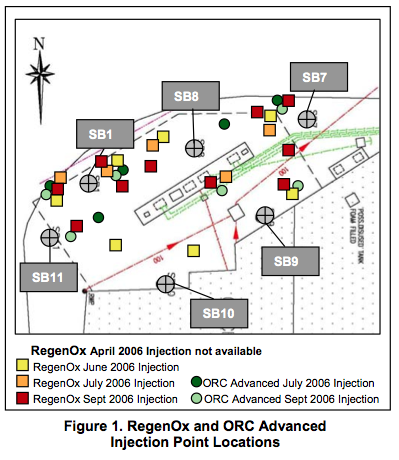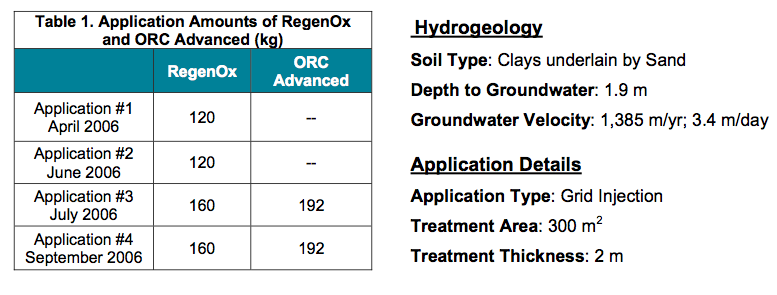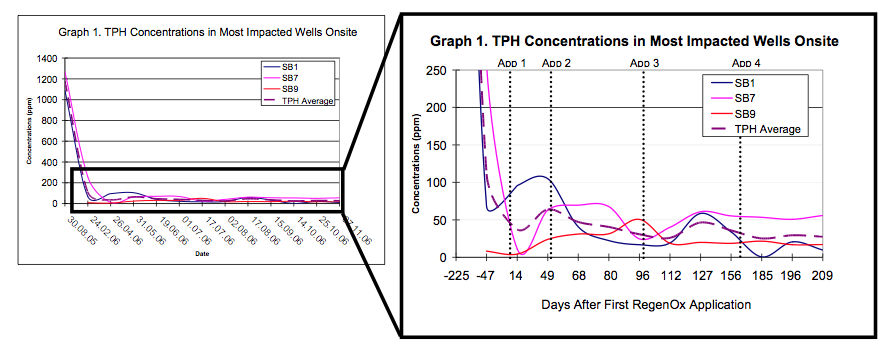Combined RegenOxTM and ORC Advanced® Application Treats TPH and BTEX
Introduction
Operations at a former car dealership resulted in petroleum hydrocarbon contaminated soil and groundwater. In the source well SB7, groundwater concentrations of total petroleum hydrocarbons (TPH) had increased to 250 parts per million (ppm) and concentrations of benzene, toluene, ethylbenzene, and xylenes (BTEX) were present at more than 400 ppm. In order to reach the TPH site specific target level (SSTL) of 19.2 ppm, a combined remedial approach using chemical oxidation and enhanced aerobic bioremediation was implemented. Injections of RegenOxTM and ORC Advanced® were applied in four separate injection events (Table 1). The combined approach was designed to treat the high concentrations and promote aerobic bioremediation of any remaining residual contamination.

Remediation Approach
The remedial objective was to reduce high concentrations of TPH to below the SSTL of 19.2 ppm. RegenOx was applied in April 2006 and June 2006 across the plume (Figure 1). Both RegenOx and ORC Advanced were applied separately in July 2006 and September 2006. (Table 1)

In Situ Treatment Results
 Shortly after the initial RegenOx chemical oxidation treatment, TPH was reduced by an average of 67% (Graph 1). As is typical following the first chemical oxidation application, contaminant rebound occurred after approximately one month. This is primarily a result of rapid desorption of sorbed phase contaminants from soil into groundwater and the 30 day longevity of RegenOx. Three follow up RegenOx injections were applied to continue treatment and eliminate the remaining contamination. Additionally, two ORC Advanced injections were performed to provide a long-term (12 months on average) oxygen source for enhanced aerobic bioremediation.
Shortly after the initial RegenOx chemical oxidation treatment, TPH was reduced by an average of 67% (Graph 1). As is typical following the first chemical oxidation application, contaminant rebound occurred after approximately one month. This is primarily a result of rapid desorption of sorbed phase contaminants from soil into groundwater and the 30 day longevity of RegenOx. Three follow up RegenOx injections were applied to continue treatment and eliminate the remaining contamination. Additionally, two ORC Advanced injections were performed to provide a long-term (12 months on average) oxygen source for enhanced aerobic bioremediation.
RegenOx was effective at reducing TPH to below the SSTL in all wells, excluding SB7 (Graph 1) which was located within the source area. However, a reduction of 95% occurred in SB7 within two weeks of the initial RegenOx injection. Rebound was observed in this area throughout the treatment, indicating that sorbed phase TPH was more prevalent around this well. RegenOx reduced the overall TPH loading of the soils and maintained TPH concentrations in groundwater to below 60 ppm. The ORC Advanced applications are expected to further TPH reduction in this area via enhanced aerobic biostimulation beyond the length of the monitoring program.
Conclusion
As a result of the RegenOx applications, concentrations were reduced quickly and cost-effectively within weeks of the injections. It is expected that the remaining concentrations above the SSTL in Graph 1 will be reduced as ORC Advanced continues to release oxygen. Successful closure was achieved due to the overall reduction in TPH concentrations, the observed reduction in contaminant concentrations in the source area, and the expected future reductions from the application of ORC Advanced.


 Americas
Americas Europe
Europe Français
Français Deutsch
Deutsch Italiano
Italiano Español
Español
